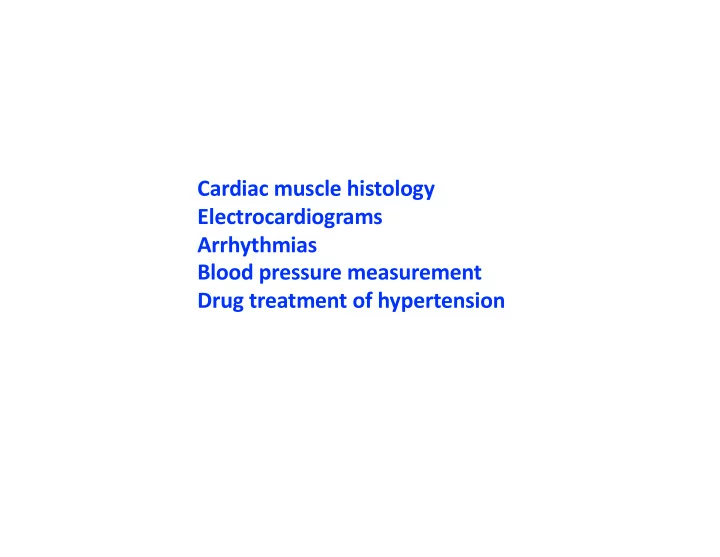

Cardiac muscle histology Electrocardiograms Arrhythmias Blood pressure measurement Drug treatment of hypertension
Cardiac Muscle intercalated discs mechanical connections between cells • contain gap junctions • Figure 14.5h, p. 442
Cardiac muscle has intercalated discs Wheater Figure 8.3 Cardiac muscle—arrows indicate intercalated discs Be able to identify: type of tissue: cardiac muscle • structure: intercalated disc •
Wheater, Fig. 6.26: High magnification electron micrograph of an intercalated disc
Cardiac muscle is electrically coupled gap junctions are channels that • allow action potentials to be conducted from cell to cell Figure 3.8b, p. 74
Wheater, Fig. 6.26: High magnification of an intercalated disc FA: fascia adherens: site of mechanical linkage N: nexus junction: region where gap junctions are located
Electrocardiogram
Interpretation of electrocardiograms (ECG) Figure 14.16f; p.457 From Figure 14.16g; p.457
Patient with arrythmia A 65-year-old man who had been treated for hypertension for the past 10 years presented with increasing fatigue, dizziness, and palpitations. He did not have chest pain or any other symptoms. An electrocardiogram (ECG) was obtained. Figure 1 in JAMA (2019) 322 (7): 688-689 What might cause fatigue and dizziness? Are there P waves? Are there normal QRS waves? What is the heart rate? Is the heart rate regular?
Atrial fibrillation erratic electrical activity in atria • causes fibrillatory waves with no P waves excitation of ventricles is via • normal path through AV node so QRS is normal-looking excitation randomly enters AV • node to cause irregularly irregular R-R intervals can cause tachycardia • Figure 2 in JAMA (2019) 322 (7): 688-689 https://jamanetwork.com/journals/jama/fullarticle/2748482
Fibrillation: irregular and uncoordinated contraction of cardiac muscle atrial fibrillation ECG: no P waves atria don’t pump blood • treated with anti- • clotting drugs ventricular fibrillation ECG: no QRS waves ventricles don’t pump blood • rapidly fatal • treated with defibrillator • ECG traces from Figure 14.16g, p. 457
AV node conduction block Does a QRS wave follow each P wave? Does the QRS wave look normal? What is the heart rate?
AV node conduction block Does a QRS wave follow each P wave? Does the QRS wave look normal What is the heart rate? What is acting as the pacemaker of the heart?
Premature ventricular contraction From Becker, D. (2006) Anesth. Prog. 53 : 53-64 https://www.ncbi.nlm.nih.gov/pmc/articles/PMC1614214/pdf/i0003-3006-53-2-53.pdf Are there normal QRS waves following P waves? Are there abnormal QRS waves? Are all the QRS waves the same shape? How many ectopic foci are there?
Arterial pressure the blood pressure oscillates between a high systolic pressure • and a low diastolic pressure the mean arterial pressure ( MAP ) is the average pressure • throughout the entire cycle the pulse pressure is the difference between the systolic • pressure and the diastolic pressure systolic and diastolic pressure measured using a • sphygmomanometer MAP See this page: https://www.physiologyweb.com/calculators/mean_arterial_pressure_calculator.html
Blood pressure measurement Figure 14.7, p. 483
Blood pressure measurement systolic pressure diastolic pressure Adapted from Figure 3 https://opentextbc.ca/anatomyandphysiology/chapter/20-2-blood-flow-blood-pressure-and-resistance/ What causes the sounds? Turbulent flow through the narrowed artery.
Ensuring accurate measurement of blood pressure 1. Cuff should be at the level of the heart à gravity will change the reading if the arm is above or below the heart. What happens to the blood pressure reading if the cuff is above the heart? What happens to the blood pressure reading if the cuff is below the heart? 2. Patient must be positioned properly à relaxed, sitting with feet flat on the floor an back supported. Patient should be seated for 3-5 minutes without talking or moving before taking the first BP reading. 3. Cuff must fit properly and be placed on bare skin. Source: Hypertension (2019) 73 : e35-e36 https://www.ahajournals.org/doi/full/10.1161/HYP.0000000000000087
Automated blood pressure monitor oscillometric device: measures the waveform of pressure fluctuations in • the artery as pressure in the cuff decreases calculates systolic pressure and diastolic pressure based on changes in the • waveform wrist cuff
Calculations pulse pressure (PP) = systolic pressure (SP) – diastolic pressure (DP) PP = SP - DP mean arterial pressure (MAP) = about a third of the way between DP and SP MAP = DP + 1/3 PP
Blood pressure medications diuretics ACE inhibitors Angiotensin II receptor antagonists Ca ++ channel blockers
Mean arterial pressure Figure 15.8a, p. 485
Blood plasma is part of the extracellular fluid Figure 5.1b, p. 123 Figure 16.1, p. 512 à blood volume is related to extracellular fluid volume
The kidneys regulate extracellular fluid volume by regulating the amount of Na+ in the extracellular fluid sensors detecting regulated changes in ECF volume variable
Diuretics decrease ECF volume by inhibiting Na+ reabsorption in the nephron
The kidneys regulate extracellular fluid volume by regulating the amount of Na+ in the extracellular fluid sensors detecting regulated changes in ECF volume variable increased renin secretion part of kidney response to decreased ECF volume
Renin-angiotensin-aldosterone system angiotensin II causes vasoconstriction aldosterone promotes Na + reabsorption in the distal nephron ACE inhibitors decrease formation of angiotensin II • angiotensin II receptor antagonists block angiotensin II signaling •
Ca ++ channel blockers decrease peripheral resistance by reducing vascular smooth muscle contraction arterioles M: smooth muscle Wheater Figure 8.12a
Recommend
More recommend